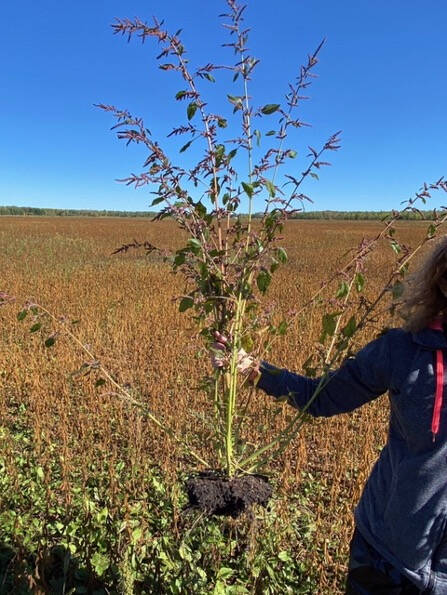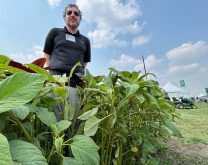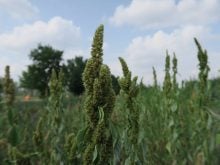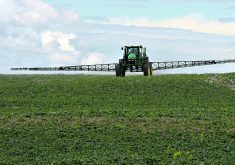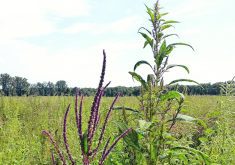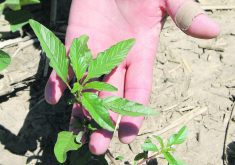Waterhemp has dropped a grade in several parts of Manitoba.
The invasive species has been downgraded from a Tier 1 to a Tier 2 noxious weed in 28 municipalities where it has dug a foothold, Manitoba Agriculture has said.
The change to Manitoba’s Noxious Weeds Act reflects the reality that waterhemp can no longer be considered rare or isolated in these areas, said provincial weed specialist Kim Brown.
Read Also

Soybean market still figuring out implications of China-U.S. pact
Soybean futures had a muted reaction to the U.S. trade deal with China as the market tries to figure out the nuances of the deal.
“It has been confirmed in 28 rural municipalities in Manitoba (and) as of 2024, it’s rapidly spreading,” she said.
The weed remains classified as Tier 1 in RMs where it has not yet been confirmed.
Under the revised classification, small infestations of waterhemp in Tier 2 areas must still be destroyed. However, for larger field-wide infestations, the requirement shifts from destruction to control measures aimed at preventing spread, Brown told participants at a Manitoba Agriculture Crop Talk webinar late last month.
“As a Tier 2 weed, we still must destroy those small infestations so that (it) cannot be allowed to stay … because we know there’s an awful lot that are there (and) they’re coming in loaded with resistance already,” Brown said.
Waterhemp was first spotted in the province in 2019.
It is a known headache for farmers, thanks to its tendency to develop herbicide resistance. It’s also difficult to scout for early enough because it is easily confused for more common and less problematic weeds.
By the time farmers know what they’re up against, the weeds have outgrown their more vulnerable stages, or they’re resistant to the chemicals being used against them. The only remaining options, Brown said, are hand mowing and weeding.
Waterhemp’s biology gives it a step up against herbicides. It is a dioecious species, with both male and female plants that cross-pollinate. This allows for a lot of genetic diversity, the Manitoba Crop Alliance website notes. Resistance genes can spread rapidly through pollen transfer.
At the same time, the weed is noted for its prolific seed production and its ability to germinate easily. Once the plant figures out how to beat the chemistry, there’s a lot of offspring to pass the trait down to.
“We know that glyphosate is not working,” Brown said.
“Lots of Group 2s don’t work. Our Group 14s may not be working. Group 5s may not work, and we know we have some Group 4 resistance showing up as well.”
Manitoba’s waterhemp findings are still mostly in the southeast, although there have been isolated cases in unexpected locations, including the Dauphin area and the RM of Ellice-Archie.
“The birds basically are eating the weed seeds down south and depositing them as they fly north. And they can also move in flood waters,” Brown said.
The weed can also be spread through dirt or seeds hiding in nooks and crannies of farm equipment.
Manitoba Agriculture has some advice for farmers trying to determine if they’ve just got more redroot pigweed, or if there’s something worse lurking in their fields.
“Sometimes (waterhemp) leaves are a bit longer and skinnier than a regular redroot pigweed. It can be kind of a darker, shiny green leaf; not all the time, but lots of times,” Brown said.
“And the stems and the leaves and the petioles … which are the stems that attach the leaf to the main stem, those are very, very smooth.”
The cotyledons of young waterhemp plants also differ from other pigweeds. They are wider and more tapered. In other pigweeds, they tend to be long and narrow, shaped like a cigar.
Early detection critical
Under Manitoba’s Noxious Weeds Act, landowners and residents are responsible for controlling noxious weeds on their property, with enforcement handled at the municipal level.
Farmers should contact Manitoba Agriculture with suspected waterhemp sightings. Even small, initial infestations can quickly become overwhelming, Brown said.
“If you even start with a few plants on a field and do absolutely nothing, within three to four years, you can have that weed like a solid field, side to side. It’ll be corner to corner on that field.”


